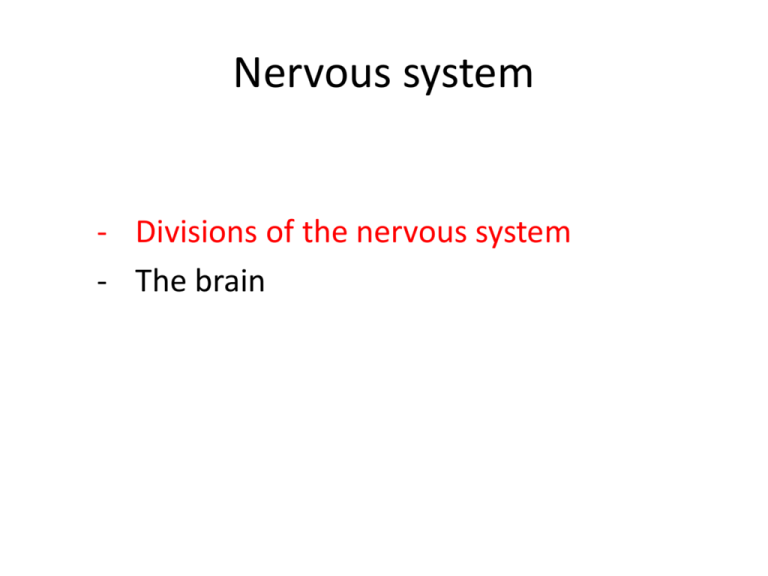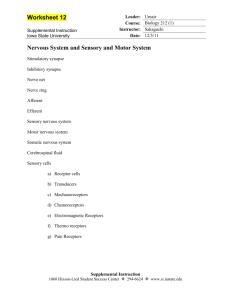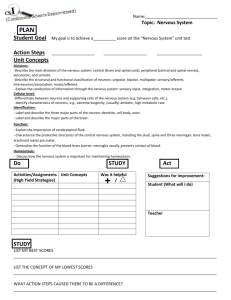Unit3-NervousSystemWeb
advertisement

Nervous system - Divisions of the nervous system - The brain In which form is the message carried by the sensory By nerve impulses and the motor pathways? MOTOR NEURON SENSORY NEURON RECEPTORS What 2 types of effectors are there? Muscles EFFECTOR Glands What is the result of their Contraction Secretion stimulation? The nervous system analyses sensory information from the 1 body environment 2 and the external 3 The information is analysed and appropriate voluntary and involuntary motor responses are made which lead to 4 muscular contractions or glandular secretions 5 6 7 Some of the information is stored for future use. What is the function of sensory neurons? Carry impulses from receptors to the CNS. What is the function of motor neurons? Carry impulses from the CNS to effectors. Structural division of the nervous system NERVOUS SYSTEM CENTRAL NERVOUS SYSTEM BRAIN SPINAL CORD PERIPHERAL NERVOUS SYSTEM • In which 2 parts can the peripheral nervous system be divided in? • Somatic Nervous System (SNS) • Autonomic Nervous System (ANS) • What is the function of the Somatic NS? • Sensory and motor neurones of the somatic nervous system (SNS) control the mostly voluntary movement of skeletal muscles. • Example of functions controlled by the Somatic NS? • Walking and speaking • What is the function of the Autonomic NS? • To regulate the internal environment by the involuntary control of the heart, alimentary canal, blood vessels and bronchioles. • What is the name given to the maintenance of the body’s internal environment within certain tolerable limits despite changes in the body’s external environment? • Homeostasis • In which 2 parts can the autonomic nervous system be divided in? • Sympathetic Nervous System (SNS) • Parasympathetic Nervous System (PNS) • These two systems affect many of the __________structures but have __________effect opposite same on them. antagonistic • They are said to be______________. • In broad terms, homeostatic control is through sensory neurons and motor neurons conducting involuntary impulses to what? • Smooth muscle, cardiac muscle and glands. • Sympathetic NS: • Effect on cardiac muscle? • Increased rate and force of contractions result in increased cardiac output • Effect on smooth muscle of the walls of the digestive system? • Decreased rate of peristalsis • Effect on smooth muscles in wall of bronchioles? • Tube bore dilates resulting in an increased volume of air to enter lungs • Effect on adrenal gland? • Increased rate of secretion of adrenaline • Parasympathetic NS: • Effect on cardiac muscle? • Decreased rate and force of contractions result in decrease cardiac output • Effect on smooth muscle of the walls of the digestive system? • increased rate of peristalsis • Effect on smooth muscles in wall of bronchioles? • Tube bore constrict resulting in a decreased volume of air to enter lungs • Effect on adrenal gland? • No effect- no







